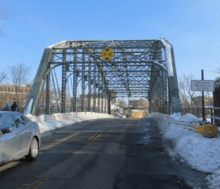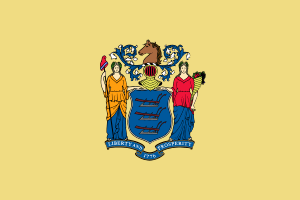Arch Street Bridge
| Arch Street Bridge | |
|---|---|
 | |
| Coordinates | 40°55′24″N 74°10′12″W / 40.9233°N 74.1701°WCoordinates: 40°55′24″N 74°10′12″W / 40.9233°N 74.1701°W |
| Crosses | Passaic River |
| Locale | Paterson, New Jersey |
| Owner | Passaic County |
| Maintained by | County |
| ID number | 1600015[1] |
| Characteristics | |
| Design | Parker truss |
| Material | steel |
| Total length | 184.1 feet (56.1 m) ft. |
| Width | 27.6 feet (8.4 m) |
| Longest span | 178.2 feet (54.3 m) |
| Number of spans | 1 |
| Clearance above | 13.7 feet (4.2 m) |
| History | |
| Constructed by | Oswego Bridge Company |
| Construction end | 1905 |
 Arch Street Bridge Location in Passaic County, New Jersey  Arch Street Bridge Location in Passaic County, New Jersey  Arch Street Bridge Location in Passaic County, New Jersey | |
| References | |
| [2][3][4][5][6] | |
Arch Street Bridge is Parker truss bridge over the Passaic River in Paterson, New Jersey. It was built in 1907 and rehabilitated in 1997. It was the third structure built at the location within a few years, the other having been destroyed by floods in 1902 and 1903.[7][8] The bridge was once a crossing for the Public Service trolley lines.
A historic bridge survey conducted by the New Jersey Department of Transportation (NJDOT) from 1991–1994 determined that the bridge is eligible for listing on the New Jersey Register of Historic Places and the National Register of Historic Places. In June 1995, the State Historic Preservation Office concurred.
See also
- Straight Street Bridge
- West Broadway Bridge
- Sixth Avenue Bridge
- List of crossings of the Upper Passaic River
- List of crossings of the Lower Passaic River
- List of crossings of the Hackensack River
- Passaic River Flood Tunnel
-
 Bridges portal
Bridges portal -
 New Jersey portal
New Jersey portal
References
- ↑ "Bridge Statistics for Paterson, New Jersey (NJ)". www.city-data.com.
- ↑ "Historic Bridge Survey (1991-1994)" (PDF). NJDOT. 2001. Retrieved 14 November 2016.
The bridge originally carried two lanes of traffic and two sidewalks over the Passaic River... It, like the other bridges in Paterson, serves as a link between the late-19th and early-20th century residential districts on the west side of the river from the industrial east side. The bridge contributes to the historic character of the area...The 11-panel pin-connected Parker thru truss bridge supported on coursed ashlar abutments is a large and well preserved example of the truss type that is not common. Parker trusses are more commonly found on rail lines rather than city streets. The span is technologically distinguished because of its type, a polygonal top chord variation of a Pratt truss, and its state of preservation. It is also historically notable as one of the significant Paterson bridges built after the 1903 flood.
- ↑ "New Jersey and National Registers of Historic Places". NJ DEP - State Historic Preservation Office. Retrieved 28 November 2016.
- ↑ "County Routes" (PDF). Passaic County.
- ↑ "Passaic County Road System". Passaic County. 2001.
- ↑ "Arch Street Bridge". Retrieved 26 October 2016.
- ↑ Ensslin, John C. (September 2, 2011). "1903 flood still ranks as North Jersey's worst". The Record. Retrieved 14 November 2016.
- ↑ Leighton, Marshall Ora (1904). "The Passaic Flood Of 1903" (PDF). Government Printing Office. p. 23. Retrieved 9 November 2016.
The bridges crossing Passaic River in Passaic, Essex, and Bergen counties were almost completely destroyed, and the damage amounted to $654,811. Within the limits of Paterson, below Great Falls, all of the highway bridges except two were either severely damaged or completely carried away. West street bridge, the first below the falls, was a Melan concrete, steel-arch structure, built in 1897, and costing $65,000. It was composed of three spans, each about 90 feet long. The flood practically split two spans longitudinally, the upstream side of each, equal to about one-third of the width of the bridge, being carried away. This structure was built to conform to the established grades of streets on both sides of the river and was completely inundated, forming a barrier for floating débris and practically making a dam in the river. Main street bridge is a 3-span, steel-arch structure, which was completely covered during the flood, but was only slightly injured. Arch street bridge, built in 1902 to take the place of a structure carried away by the March flood, was a concrete-arch bridge of three spans. It was undermined at the north pier and collapsed, being practically destroyed. The original cost of this bridge was $34,000. Its piers presented a serious obstruction to the flow of the stream, especially as the channel is very narrow at this point. In addition to this, the bridge was of low grade and admirably adapted for deterring flood flow. Below Arch street bridge all the other structures crossing the Passaic were of iron and were carried away, with the exception of Sixth avenue and Wesel bridges. Those destroyed were designated as follows: Straight street, Hillman street, Moffat, Wagaraw, Fifth avenue, East Thirty-third street, and Broadway bridges. All these structures were built too low, and were inundated during the early stages of the flood.
This article is issued from Wikipedia - version of the 12/1/2016. The text is available under the Creative Commons Attribution/Share Alike but additional terms may apply for the media files.